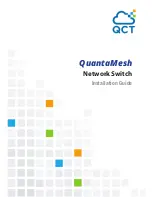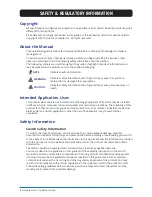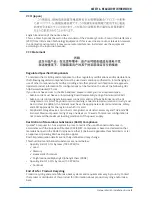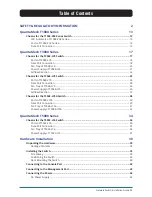
Network Switch lnstallation Guide
7
SAFETY & REGULATORY INFORMATION
Rack Mount Warnings
The following installation guidelines are required by UL for maintaining safety compliance when
installing your into a rack.
• The equipment rack must be anchored to an unmovable support to prevent it from tipping
when a server or piece of equipment is extended from it. The equipment rack must be
installed according to the rack manufacturer’s instructions.
• Install equipment in the rack from the bottom up, with the heaviest equipment at the bottom
of the rack.
• Extend only one piece of equipment from the rack at a time.
• You are responsible for installing a main power disconnect for the entire rack unit This main
disconnect must be readily accessible, and it must be labeled as controlling power to the
entire unit, not just to the server(s).
• To avoid risk of potential electric shock, a proper safety ground must be implemented for the
rack and each piece of equipment installed in it.
• Elevated Operating Ambient - If installed in a closed or multi-unit rack assembly, the operating
ambient temperature of the rack environment may be greater than the room ambient.
Therefore, consideration should be given to installing the equipment in an environment
compatible with the maximum ambient temperature (Tma) specified by the manufacturer.
• Reduced Air Flow - Installation of the equipment in a rack should be such that the amount of
air flow required for safe operation of the equipment is not compromised.
• Mechanical Loading - Mounting of the equipment in the rack should be such that a hazardous
condition is not achieved due to uneven mechanical loading.
• Circuit Overloading - Consideration should be given to the connection of the equipment to
the supply circuit and the effect that overloading of the circuits might have on overcurrent
protection and supply wiring. Appropriate consideration of equipment nameplate ratings
should be used when addressing this concern.
• Reliable Earthing - Reliable earthing of rack-mounted equipment should be maintained.
• Particular attention should be given to supply connections other than direct connections to
the branch circuit (e.g. use of power strips).
Other Hazards
Battery Replacement
• There is the danger of explosion if the battery is incorrectly replaced. When
replacing the battery, use only the battery recommended by the equipment
manufacturer.
• Dispose of batteries according to local ordinances and regulations.
• Do not attempt to recharge a battery.
• Do not attempt to disassemble, puncture, or otherwise damage a battery.
CAUTION
Cooling and Airflow
• Carefully route cables as directed to minimize airflow blockage and cooling
problems. For proper cooling and airflow, operate the system only with the
chassis covers installed. Operating the system without the covers in place can
damage system parts. To install the covers:
√ Check first to make sure you have not left loose tools or parts inside the
system.
√ Check that cables, add-in cards, and other components are properly
installed.
√ Attach the covers to the chassis according to the product instructions.
CAUTION








































